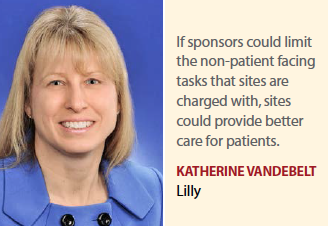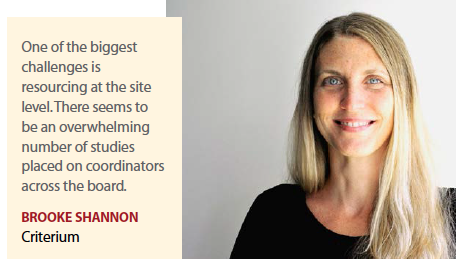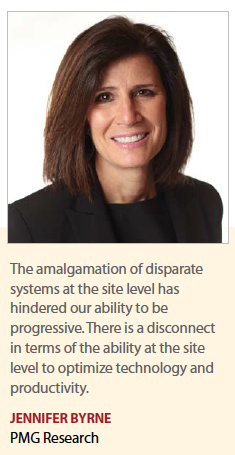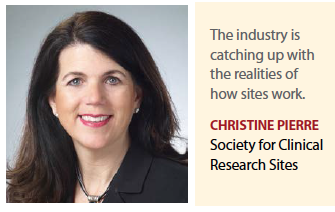 Clinical sites face several challenges, including predictability of trial business, payments, and technology issues, in addition to a highly fragmented clinical trial landscape.
Clinical sites face several challenges, including predictability of trial business, payments, and technology issues, in addition to a highly fragmented clinical trial landscape.
Many of the challenges that sites face reflect the changing landscape of clinical research. Sites are responsible for much of the non-patient facing work related to the business of clinical research, including finding trials, filling out feasibility surveys, negotiating contracts, learning new software that’s chosen by sponsors, filling out documentation, either prescreening logs or recruitment logs for sponsors or CROs, creating source stock to run their clinical trial at their site and sometimes doing double data entry.
“Sites would like to spend more time with their patient-facing work, which is recruitment, screening, actually performing the assessments that the protocol outlines, doing the data collection and overseeing the care of their patient," says Katherine Vandebelt, global head, clinical innovation, Lilly.
But even patient-facing work that sites manage has become more complicated, Ms. Vandebelt says. Sites are responsible for making sure patients qualify for the study, performing many procedures and determining whether they can do these procedures in the time required by the protocol.
“If we as an industry can limit sites’ non-patient facing tasks as much as possible, it will increase the job satisfaction of the people involved in clinical research and help them provide better care for their patients," she says. “I also think costs would come down."
 Jeanne Hecht, senior VP and global head of site and patient networks, Quintiles, says changes in the clinical trial industry have resulted in changes in what sponsors and CROs expect from sites.
Jeanne Hecht, senior VP and global head of site and patient networks, Quintiles, says changes in the clinical trial industry have resulted in changes in what sponsors and CROs expect from sites.
“The administrative burden of running a trial and the paperwork that’s often required doesn’t follow the flow of clinical practice," she says. “The way protocols are designed doesn’t always align with how the standard of care flows through a clinical practice. A number of our research sites are run by clinical practitioners, and for them balancing clinical practice with research may mean changes for their office hours, their staff, and the ancillary departments that support them. This puts a burden on them." (See related story in this issue: Principal Investigator Turnover)
Jennifer Byrne CEO of PMG Research says an average clinical visit — including patient, technology, and administrative time — has increased to about four hours.
“This has been one of the most significant and negative developments," she says. “The research staff only has so many hours in the day. So our ability to bring through more patients becomes challenging because any given interaction with a patient takes longer."
Also, often there is a lack of transparency to the overall study management plan in terms of the sites, says Edmond McLindon II, VP, SMO affairs, ICON.
“This results in decisions being made at the program level that conflict with the site’s study delivery plan," he says. “For example, instances of shipping logistics, release of cohort timing, and patient technologies that need to be managed and deployed at the site level come to mind. It is important to provide sites with visibility ahead of time into planned site logistics and decisions that affect them and could compromise patient management."
Sites are key to the success of clinical trials, says Chris Watson, Ph.D., director of product strategy, Exco InTouch.
“But vendors often overlook site needs and do not understand their burdens, a fact that needs to be addressed," he says. “Trials are becoming more complex with the development of site-based eCOA, the inclusion of lab results as well as the incorporation of new medical and consumer devices into the data collection mix."
Site Payment Challenges
One such burden on sites relates to how sites are paid for their work. Industry experts say issues related to site payments can get in the way of study execution and could delay a trial, resulting in a cost impact for all involved.
Payment for clinical trial work is often plagued by slow reimbursement, calculation errors and inaccurate payments, putting financial strain on investigative sites that are already facing rising operational costs. According to an ongoing research project conducted by the Clinical Trials Transformation Initiative (CTTI), lengthy delays in payment result in high turnover rates among clinical investigators, with 40% of sites dropping out of FDA-regulated clinical trials. This high turnover rate drives up the cost of drug development, with onboarding rates averaging $40,000 per new site.
 Additionally, more than 60% of respondents receive their reimbursements quarterly, according to the Greenphire Site Payment survey conducted in March 2016. Out of this group, almost 80% of sites would prefer their sponsor/CRO partner to pay them monthly. Of those respondents receiving the payments on a quarterly basis, 59% indicated that this payment frequency has an impact on their clinical trial.
Additionally, more than 60% of respondents receive their reimbursements quarterly, according to the Greenphire Site Payment survey conducted in March 2016. Out of this group, almost 80% of sites would prefer their sponsor/CRO partner to pay them monthly. Of those respondents receiving the payments on a quarterly basis, 59% indicated that this payment frequency has an impact on their clinical trial.
Quarterly payments often put the site in a position to front costs that can quickly add up and restrict the resources at the site.
Furthermore, greater than 60% of sites polled indicated dissatisfaction with their ability to know when their payment or reimbursement from their sponsor or CRO will arrive. Without visibility into the timing of funding, sites have a difficult time planning and executing efficient operational procedures.
“Quarterly payments mean that the sites are paid at about five and a half months to six months from when they deliver the service," says Christine Pierre, president of the Society for Clinical Research Sites (SCRS). “This is such a huge issue for our sites that we have started a multi-stakeholder initiative that includes a number of sponsors and CROs and sites that are looking at addressing the site payment process. The results of that initiative will be forthcoming at the SCRS Global Site Solution Summit in October. But it’s not just the frequency of how the payments are being received; another issue is the lack of backup information pertaining to what the payment is even for."
The Greenphire survey found that sites are spending an inordinate amount of time on payment reconciliation tasks because, for many, the invoices being generated are done manually, either with spreadsheets or paper processes. In addition, many sites are still receiving checks for payments — nearly half of the respondents receive all payments via check and another 25% receive payments in both check and EFT format, which adds complexity and time.
The sites polled by Greenphire agreed that manual payment and reconciliation processes are extremely error prone, and that there is an opportunity for them to be streamlined to improve site operations.
Finally, sites overwhelmingly agree that the industry’s focus on automating manual processes related to data capture should be extended to payment processes to fully optimize and streamline site performance.
Ms. Pierre says SCRS advocates for every site to be paid 30 days from when the service was rendered and the data entered.
 “Data entered is the critical element of when payment should be due from our perspective," she says. “The data are what the industry is ultimately partnering with the site to provide, to prove or disprove the viability of a molecule or device. Sites have a responsibility to get the data in a timely fashion and SCRS’ best site practice is within five days of the visit. Once the data are in, payment should be triggered within 30 days. There’s no reason it shouldn’t be triggered at that point."
“Data entered is the critical element of when payment should be due from our perspective," she says. “The data are what the industry is ultimately partnering with the site to provide, to prove or disprove the viability of a molecule or device. Sites have a responsibility to get the data in a timely fashion and SCRS’ best site practice is within five days of the visit. Once the data are in, payment should be triggered within 30 days. There’s no reason it shouldn’t be triggered at that point."
The current process of payment, Ms. Pierre says, is based on a legacy system when data were collected on paper, monitors came to sites to review data, and then data were entered at the sponsor organization.
Ms. Byrne says, from a reimbursement standpoint, the industry is still living in a 20th century model matrix.
“This does not align with 21st century healthcare," she says. “The fee-for-service model that pharma continues to pay on a ‘fair market value’ does not translate to the trend in healthcare today. Healthcare is moving toward reimbursement based on value and value is a function of time and cost as it relates to outcome."
To help address this issue, Greenphire has joined SCRS’ Global Impact Partner (GIP) program. As a GIP, Greenphire will participate on the SCRS Global Impact Board at an executive level and work closely with its leadership council to determine strategic initiatives. Greenphire kicked off its involvement by joining the SCRS Site Payments Initiative meeting in May.
Ms. Byrne says there is a need for pharma and the service providers to become more educated with respect to the site and healthcare organizations that they are hiring for their clinical trial work.
“Sponsors and CROs have to be more involved in understanding the compensation models in those systems and how these activities will translate in terms of those institutions’ actual costs within their structure," she says.
Ms. Pierre points out that now that data are being captured and sites are entering data directly into electronic data systems the process for payment must change.
 “We are moving forward with efforts to have data extracted from electronic health records and directly transported into EDC systems," she says.
“We are moving forward with efforts to have data extracted from electronic health records and directly transported into EDC systems," she says.
“But we are still holding onto legacy payment models akin to how we managed data 20 years ago."
Additionally, Ms. Pierre says, documentation should accompany payment that indicates what the check is for, in granularity, including the patient and the date of visits, and if necessary, the elements of that visit.
Sometimes sites are paid per visit irrespective of what is done and sometimes they get paid on line items of elements that were conducted within that visit.
“SCRS advocates that the payment details should mirror the budget and all of this information should accompany the check," Ms. Pierre adds.
Thankfully, the industry is beginning to address this issue. Earlier this year, SCRS kicked off the site payment initiative, which is being co-lead by Novartis, INC Research, and SCRS.
The purpose of this initiative is to establish an industry standard for the frequency and process of how sites receive payments for work conducted related to industry sponsored clinical research.
Technology suppliers are also beginning to acknowledge the site payment challenge. For example, in July Medidata launched Medidata Payments, which enables clinical trial sponsors and contract research organizations to calculate reimbursements to investigative sites in real time and automatically disburse payments.
Introduced in 2009 as a module within the Medidata Clinical Cloud, Medidata Payments has evolved into a large-scale, stand-alone solution that identifies and calculates withholding tax, captures indirect tax and performs global disbursement.
Ms. Vandebelt says Lilly pays sites through an invoice versus an interval method, which has been well received by site partners because they receive payment in a timely manner.
“Payment is a pain point in the system but no one solution works perfectly for everybody," she says.
Technology Challenges
Investigative sites are being inundated with a growing number of technology solutions that are difficult to use and are not compatible, according to a new study conducted by CenterWatch.
 In fact, on average, the typical investigative site is working with 12 different systems to collect clinical research data, and the majority of investigative sites feel strongly that there are too many usernames and passwords that they must manage.
In fact, on average, the typical investigative site is working with 12 different systems to collect clinical research data, and the majority of investigative sites feel strongly that there are too many usernames and passwords that they must manage.
Fewer than 10% of investigative sites believe that clinical trial technology solutions provided by sponsors and CROs are meeting their operating needs well.
In the CenterWatch analysis, investigators said technology systems provided by sponsors and CROs for clinical trials create duplicative work since information from patient site visits or laboratory tests must be transcribed from paper or electronic sources manually into study software.
Sites are required to work with more vendors than in the past, which adds to the complexity at the site level.
Finally, sites are responsible for a growing number of technologies that study volunteers are asked to use such as electronic diaries and wearable devices. ePRO technologies are given the lowest marks by sites for reliability.
Mr. McLindon says the issue for sites is that many of the technology solutions — patient engagement, recruiting as well as data collection tools, wearables, CTMS, EDC, etc. — present fantastic potential, but in many cases the site does not have a vote in which technologies to deploy for the study.
“In addition, and in most cases, each technology deployed includes a unique login ID and password," he says. “At a minimum, sponsors and CROs should seek to deploy platform technologies that provide sites with single sign-on capabilities so they don’t have to manage multiple URLs and password combinations."
In fact, investigative sites used about 10 different software applications to manage clinical studies in 2015, according to the CenterWatch survey.
Almost half of sites reported they believe sponsors and CROs require them to manage too many separate technologies.
And 23% of sites said the various technology solutions available today are not meeting site operation needs and the rise in the number of eClinical technologies has created inefficiencies and productivity challenges.
The implications of this are tremendous. Dr. Watson points out that, according to the Tufts Center for the Study of Drug Development, 40% of FDA-registered investigators drop out each year.
“If this trend continues we’ll see more and more veterans quitting and novices dropping out before they have done enough studies to grow their skills, so the sites workforce will become skewed toward inexperienced investigators," he says.
“It’s easy for sponsors, CROs and vendors to provide solutions to sites under the assumption that their trial will be the main focus of that site’s staff’s day," Dr. Watson continues. “In reality, the solution will be just one of a number of systems a site’s staff needs to use to manage their trials and all that has to be balanced alongside day-to-day operational activities."
Ms. Byrne says while technological advancement in theory can offer a lot of obvious benefit in real-time data collection and transparency of data, the amalgamation of all these disparate systems at the site level have hindered sites’ ability to be progressive.
“There is a disconnect at the site level in terms of optimizing productivity because we don’t have a bundled solution in a given trial," she says. “In addition, these different systems have different vendors and so if there is a technological glitch with one of the technologies then it can bring to a halt a site’s entire work flow."
 Dr. Watson says the challenge is to create technology that fits in with the existing workflows of the site staff and makes their lives easier, instead of burdening them with another task and not giving them adequate benefits in compensation.
Dr. Watson says the challenge is to create technology that fits in with the existing workflows of the site staff and makes their lives easier, instead of burdening them with another task and not giving them adequate benefits in compensation.
“Experience gained from patient-facing technologies is instructive when trying to address this challenge," Dr. Watson says. “Similar to investigators, patients are disinclined to use tools that disrupt their lives and offer little in return. Therefore, it is important to create a solution that integrates into a site’s natural day-to-day schedule and adds tangible value, rather than seeming like just another task to complete. By incorporating patient-specific information into an overall workflow, either for an individual trial or for the range of trials currently under a site’s supervision, it is possible to create a truly advantageous system that uses the information to focus investigator actions and automates many patient-support actions."
Ms. Byrne suggests pharma and CROs think more about piloting the trial design before it goes live.
“An opportunity to pilot the trial design and test the flow of the technology before activating site start up would be really meaningful," she says.
“CROs and pharma sponsors are moving toward having preferred site relationships. They have a great opportunity to take those relationships to the next level. By doing so, they can tap into a handful of sites and test pilot trials in the field before they are actually activated. We’ve had a number of opportunities to do this and it makes a huge difference."
Brooke Shannon, associate director of clinical operations at Criterium, says one of the biggest challenges is resourcing at the site level.
“There seems to be an overwhelming number of studies placed on coordinators across the board, who are overwhelmed with the workload," she says. “So many of the new technologies push more of the burden from the sponsor and CROs over to the site. With that comes a lot of additional work on their side. With data entry and the EDC system management for each study now at the site level, a site could have five studies going on at one time and have five different EDC systems that they have to have up and running."
Ms. Shannon says more frequent monitoring visits and training and support can help to address this challenge.
Ms. Pierre notes that the industry is catching up with the realities of how sites work, and one example of how sites’ technology challenges can be addressed is TransCelerate’s Shared Investigator Platform, a single platform that delivers content and services to investigator site and provides a single point of access for interaction with the participating clinical trial sponsor.
Launched in January 2016, this portal provides a central system access via one user account login and password, delivers harmonized processes, content and services, and reduces redundant requests for information and training, and increases the automation and re-use of data.
The Shared Investigator Platform is closely connected to TransCelerate’s Investigator Registry Initiative, a shared repository of investigator details. The IR links together profiles from the investigator platform with TransCelerate member companies’ clinical trial management systems, the DrugDev investigator network, public data and other third party sources using the universal identifier, known as the DrugDev Golden Number.
While this is a positive for the sites and sponsors that are a part of the TransCelerate program, it doesn’t address the hundreds of other sponsors and CROs that are not part of the TransCelerate program.
Ms. Vandebelt says while it’s great that groups like TransCelerate are trying to get pharmaceutical companies to come together and provide some standardization, the industry really needs to change its mindset around the information that sponsors are asking these sites to create over and over.
“Companies should be leveraging a better way to create, share, and give access to information," she says. “We don’t have a common practice that the sites can use to make information exchange easier. Cloud computing can help here.
“At Lilly, we are spending a tremendous amount of time trying to figure out ways that we can significantly ease the burden of this information sharing," Ms. Vandebelt continues.
Solutions for Sites
The Society for Clinical Research Sites, whose mission is to give sites a voice, has been working with the industry to develop solutions for some of the challenges sites face.
One such initiative is the Site Study Dashboard. This initiative — developed by the SCRS along with about 30 biopharm companies, CROs, and technology providers — is co-chaired by representatives from Allergan, Quintiles, and Apostle Clinical Trials. The initiative is intended to provide sites with valuable feedback on study metrics that matter and to encourage the exchange of information in a collaborative environment.
FDA inspections continue to highlight recurring issues with site performance and increased incidents in similar findings over the past 10 years.
But 76% of sites surveyed by SCRS say they never receive feedback from sponsors or CROs on their study performance, except for recruitment metrics.
Findings from an Allergan survey concluded investigators who received a Site Study Dashboard from Allergan reported 85% of the feedback was valuable, 71% found the metrics were helpful or extremely helpful, and 100% indicated they use the data when received to course correct and build a stronger site foundation.
Another SCRS initiative teams up with TransCelerate and the Association of Clinical Research Organizations (ACRO) for the Common Language Evaluation and Reconciliation (CLEAR) project, which aims to identify the contract clauses that matter and continue to be renegotiated.
So far, five clauses have been identified, which will be released in October, and the hope is that this common language will be adopted in master contracts.
CROs are also working to develop solutions for sites. One solution Criterium has implemented is a consortia model to use translational science methodologies to streamline cancer research and development. Each member chosen for the consortia is usually located at a hospital associated with an academic institution that has the infrastructure and staff to meet the requirements of clinical trials.
Criterium has several consortia for different cancer studies: the Academic GI Cancer Consortium; the Academic Myeloma Consortium; the Academic Thoracic Oncology Medical Investigators Consortium; and the Academic Breast Cancer Consortium.
“One challenge for sites is the lengthy start-up timeline process," Ms. Shannon says. “One of the benefits with our consortia is that we have master agreements in place with all of our academic sites. The master agreements allow us to focus on working on individual project agreements for those sites, which can help to get a project up and running."
Ms. Shannon says sponsors also like the consortia model.
Quintiles has several programs, including the Site Training and eLearning Program (STeP). This is a Web-based training program that provides sites with a practical introduction to a career in clinical research.
Quintiles plans to extend this program to sites globally and currently has 11 modules available.
STeP was developed with new professionals in mind, and includes modules that address critical topics such as: is clinical research for me, and How do I build a clinical research practice?
Ethics and quality are key parts of the eLearning program, as are operational expertise needed to prepare for a study and best practices when interacting with IRBs, project teams, and study participants.
“Managing a research site should be treated like running a business, however not all practitioners enter into research with that expectation," Ms. Hecht says. “Caring for patients in addition to managing clinical trial operations can be a challenge. Some of those sites go into research with a deficit in the number of people, processes, or infrastructure that they have in place to be able to run those trials."
Additionally, Quintiles’ Prime & Partner Site Network, a network of 24 sites and more than 1,200 partner sites that has helped to improve standards for effective trials and site relationships.
Prime sites are large hospital systems, academic institutions, and healthcare provider networks; partner sites are investigators in clinics and hospitals of every size. These global alliances help sites to increase their study volume, strengthen recruitment and data quality, and improve patient care in their clinical trials.
“We are focused on working with our sites to find patients faster for the trials we manage and we continue to invest in our site network to ensure these sites have the resources and support they need," Ms. Hecht says. “As of March 2016, time from site selection to initiation is 30% faster for Quintiles Prime & Partner Sites than for non-partner sites and these sites recruit patients on average 50% faster." (PV)



















